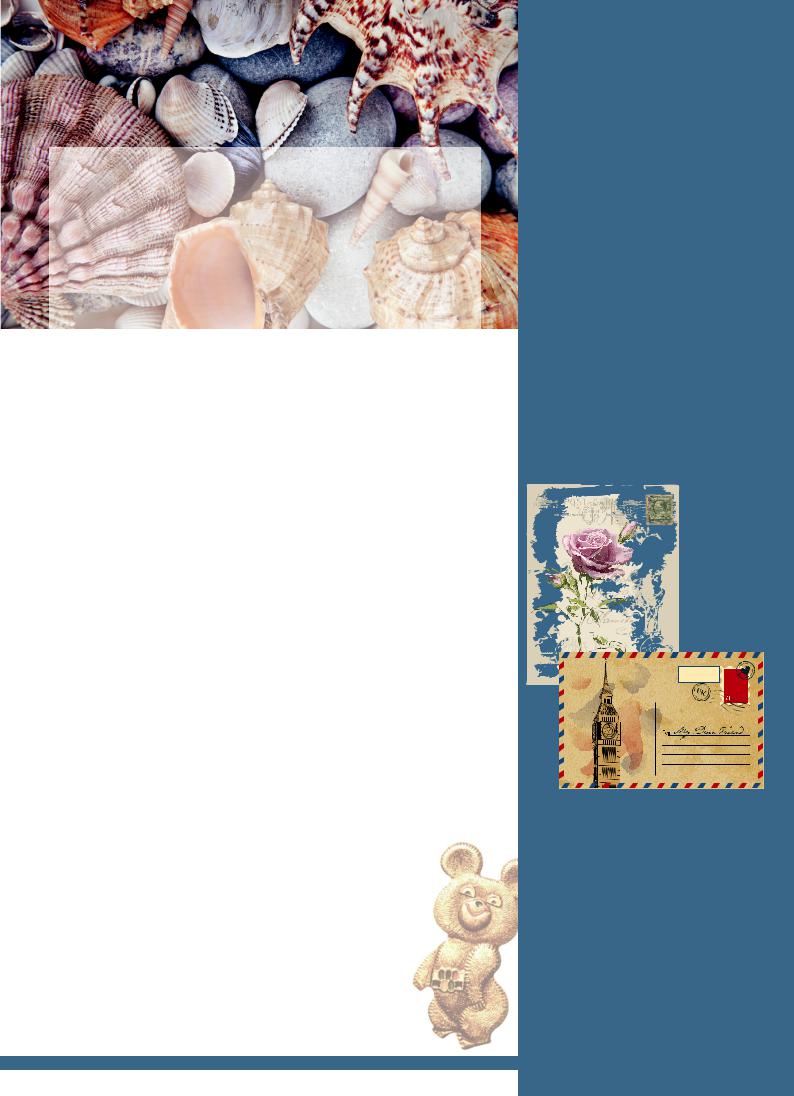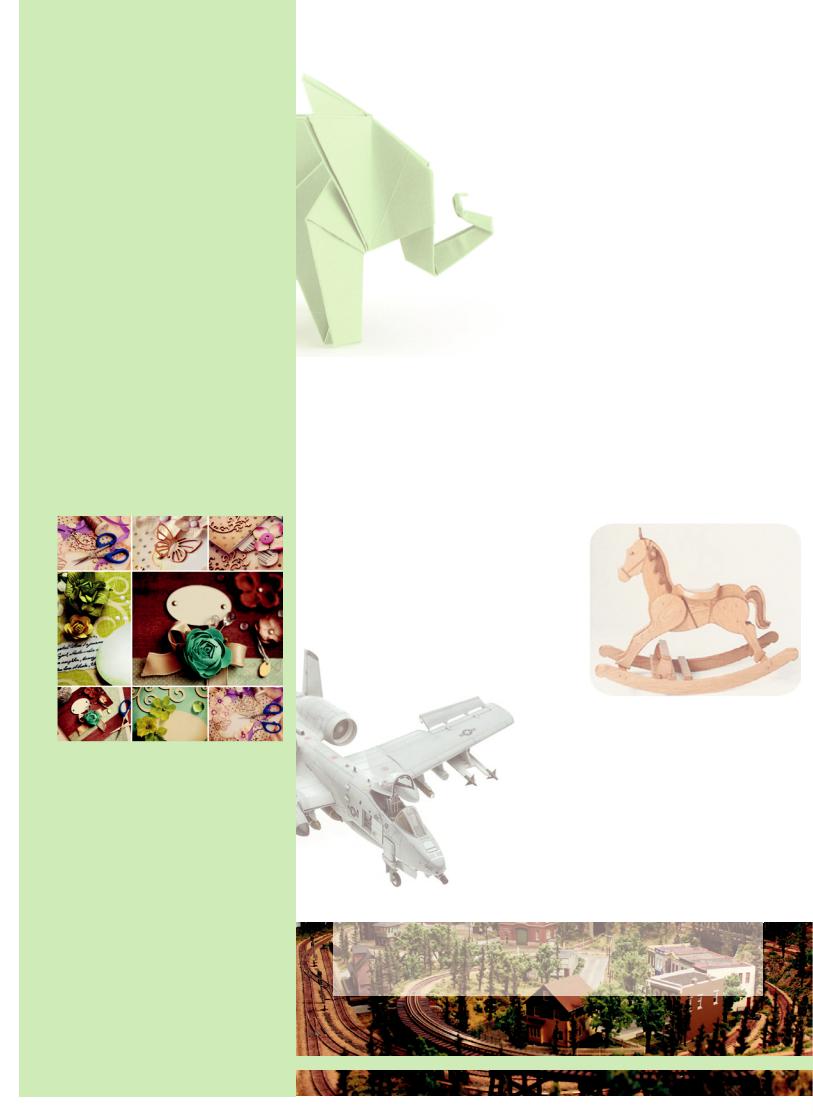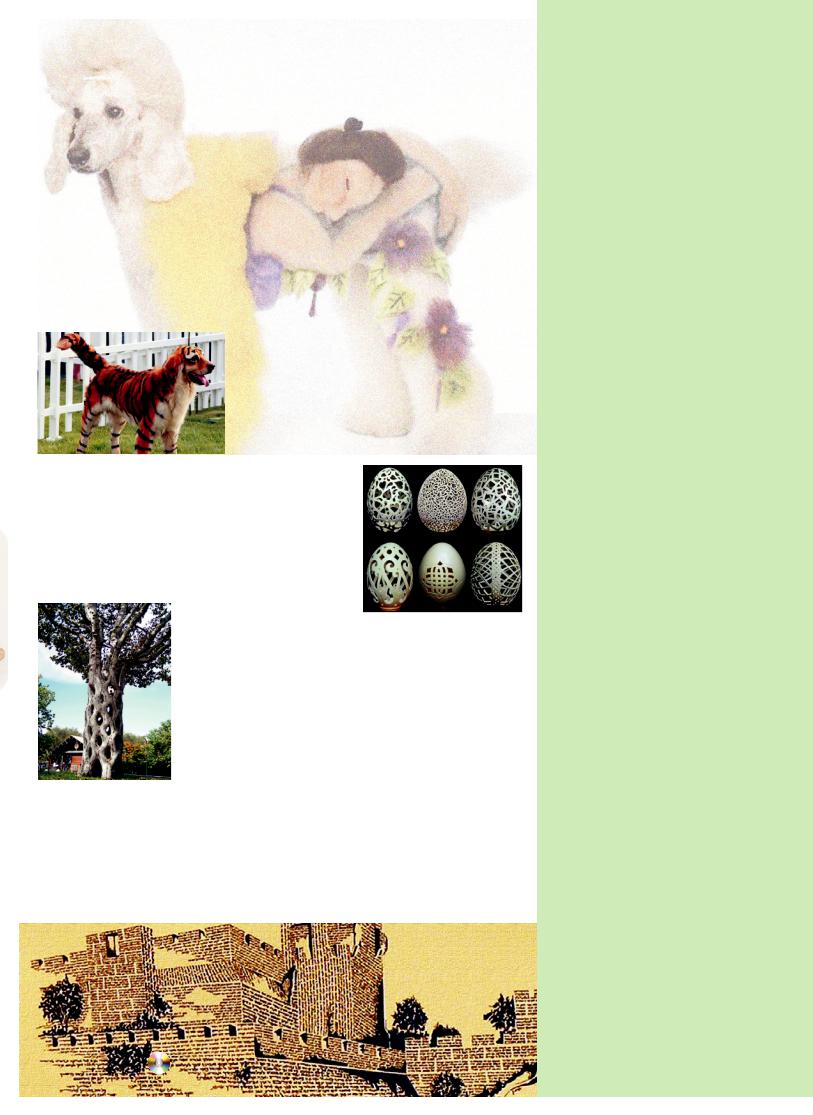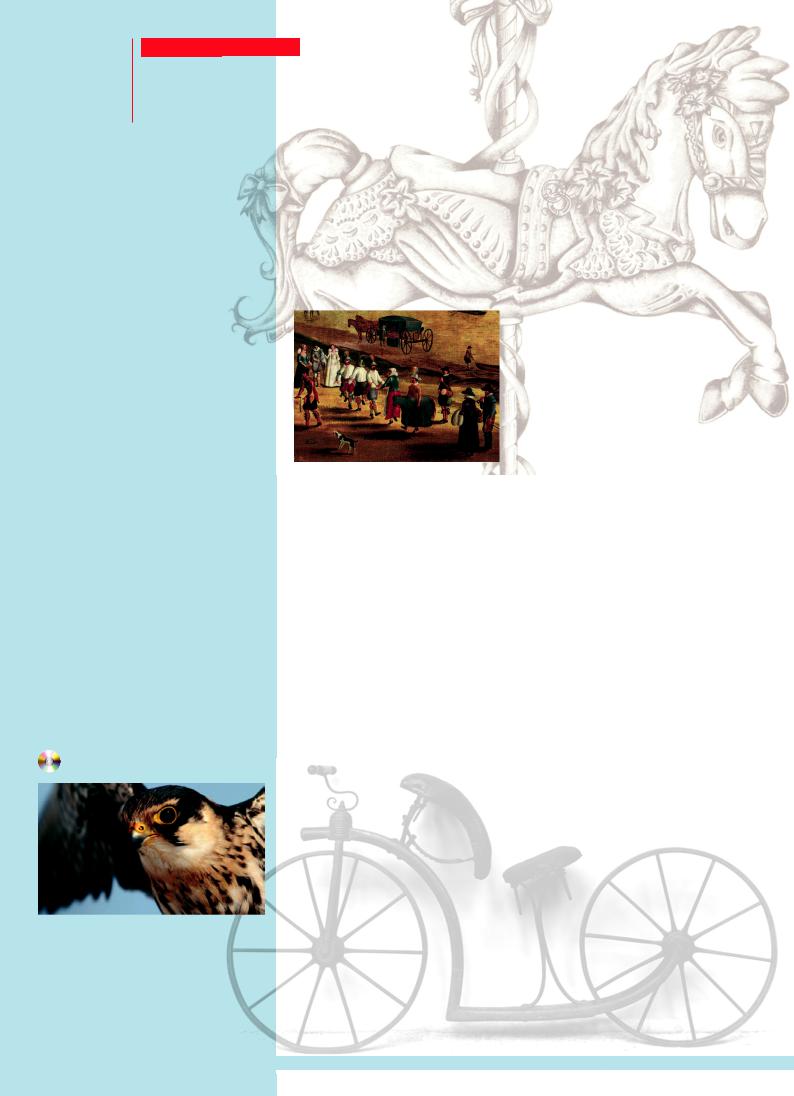
- •NEWS IN BRIEF
- •TEXTS FOR READING
- •London’s Newest Attraction and Symbol of Confidence
- •Impostor
- •METHODS OF TEACHING
- •CLASSROOM ACTIVITIES
- •English Club
- •CREATIVE WRITING
- •Hobbies Differ Like Tastes
- •FOCUS ON LANGUAGE
- •Crossword “Hobbies”
- •DISCOVERING THE PAST
- •Test Your Knowledge
- •LESSON PLANS
- •TOPICAL JOURNEY
- •Leisure Time in the Past
- •English Words and phrases for Free Time and Hobbies
- •Collecting as a Hobby
- •Interesting Facts
- •Creative Hobbies
- •Types of Hobbies
- •Popular Hobbies
- •Hobbies in Books
- •SCHOOL THEATRE
- •The Little Prince
- •PREPARING FOR EXAMS
- •My Hobbies
- •TESTS
- •Five-Minute Tests
- •FOR YOUNG LEARNERS
- •Primary School Olympiad
- •GOOD NEWS
- •YOUTH ENGLISH SECTION

THE SEASHELL COLLECTION
Seashell collecting is among one of the most interesting hobbies in the world. It is well known that sea shell collecting goes back to the times of the Roman Emperors and Egyptian Pharaohs. However, the main time of collecting and some studies of seashells began during the 2nd half of the 17th century. And seashell collecting became a hobby of many European kings and very wealthy people of that time. Some of them equipped their own vessels and hired adventurers and explorers to hunt for treasured shells.
Many who live by the seashore enjoy this fascinating hobby which costs nothing, and сollecting seashells is captivating plus great outdoor exercise. There are so many seashell types, each with its own shape and coloring plus varied coloring within the same shape. The smaller ones are plentiful, and easy to find undamaged. The goal is to find a large one in near-perfect condition.
These often break apart in the rolling surf. If they make it ashore, they could be attacked by pecking sea birds looking for any creature still inside. If that wasn’t enough,
some people will step on the seashells. Doing a sweep at very low tide, and after a storm when many have washed ashore, is the best time to find a real gem for your seashell collection.
Sanibel Island, near Fort Myers, Florida, is a shell collecting mecca. It is so common to see people gathering shells, that it is called “the Sanibel Stoop”.
VINTAGE POSTCARDS
Postcards became popular at the turn of the 20th Century, especially for sending short messages to friends and relatives. They were collected right from the start, and are still sought after today by collectors of pop culture, photography, advertising, wartime memorabilia, local history, and many other categories.
Postcards were an international craze, published all over the world. There are many types of collectible vintage postcards. Hold-to-light postcards were made with tissue paper surrounded by two pieces of regular paper, so light would shine through. Fold-out postcards, popular in the 1950s, had multiple postcards attached in a long strip. Real photograph postcards are photographs with a postcard backing.
Novelty postcards were made using wood, aluminum, copper, and cork. Silk postcards – often embroidered or with a printed image – were wrapped around cardboard and sent in see-through glassine paper envelopes, and were especially popular during WWI. In the 1930s and 1940s, postcards were printed on brightly colored paper designed to look like linen.
Most vintage postcard collectors focus on themes, like Christmas, Halloween, portraits of movie stars, European royalty and U.S. presidents, wartime imagery, and photos of natural disasters. Not to mention cards featuring colorful pictures by famous artists.
BASEBALL CARDS
Baseball cards have been around for over 150 years. While they were very different in the 1850s than they are today, the same affection for cards still lingers in the hearts of collectors across the world.
Baseball became a popular sport in the United States after the Civil War. Pasted onto the back of a piece of cardboard, the original baseball cards were called cabinet cards, as they were designed to be displayed in a cabinet. These cards were not meant to hold significant fiscal value, but today they are few and far between.
It wasn’t until the mid to late 19th century that a company called Peck and Snyder began to print the first commercial baseball cards. Peck and Snyder printed a large advertisement on the back of the card, and a famous baseball team on the front. Much like flyers that were handed out to passersby, these advertising cards, called “trade cards,” were considered the first modern baseball cards. Many people collected trade cards and scrapbooked them, and this quickly became one of America’s biggest national hobbies.
MEDALS PINS AND BADGES
The world of pins, medals, and badges ranges from hard-won military medals to readily available enameled pins purchased at places like Disneyland and the Hard Rock Cafe. Some people collect pins or participation medals from summer and winter Olympic Games, while others go for authentic sheriff and marshal badges from the days of the wild west, although such items have been widely reproduced, so collectors need to be on the lookout for fakes.
Sources: http://www.ehow.com; http://www.askmen.com; Background photo: Cluckva / Shutterstock.com
TOPICAL JOURNEY |
|
English |
|
||
|
|
31 |
|
|
April 2013 |
INTERESTING FACTS
Many famous men were shell collectors a more or less degree. This is a short list with some of these persons:
Peter I the Great (1682–1725), the Tsar and first
Emperor of Russia
Emperor Hirohito of Japan (1901–1989), was an inveterate collector of sea-shells. Until
1940, all of the slit shells caught by Japanese
fishermen had to be given to the Emperor. And nobody in Japan could own this attractive natural treasure without the Emperor’s permission.
Mary Anne (Mary Ann, Marian) Evans (1819– 1880), English novelist, who’s better known as
George Eliot.
Sir Thomas Lipton (1848–1931), the founder of the Lipton tea brand, and who was a winner of the America’s Cup 5 times with his famous racing yachts called Shamrock.
Ian Fleming (1908–1964), the creator of James
Bond.
Fidel Castro (1926), Cuban leader.
Barack Obama Has A Baseball Card
Card companies have reacted to the popularity of politics in American society, and political
figures have begun to appear on special insert cards. This year’s Upper Deck baseball includes a Presidential Predictor insert set, featuring cards of Barack Obama, Hillary Clinton, John
McCain, and others.
Taking the popularity of game-used memorabilia cards a step further, some relic cards in recent years have included swatches cut straight out of American history. It’s possible to get a card that includes a small square of cloth from one of John F. Kennedy’s suits or a card containing a piece of George W. Bush’s necktie.
Other American legends (Marilyn Monroe,
Elvis Presley, etc.) are represented with memorabilia cards in today’s products. It may seem odd to get a Marilyn Monroe card in a pack of baseball cards, but these rare inserts are hot sellers among history buffs.

English |
|
|
“The whole difference between construction and creation is |
|
TOPICAL JOURNEY |
||
32 |
|
|
exactly this: that a thing constructed can only be loved after it |
|
|
is constructed; but a thing created is loved before it exists.” |
|
|
|
|
Charles Dickens |
April 2013 |
|
|
|
Creative Hobbies
CONVERSATION QUESTIONS FREE TIME
•Do you have enough free time?
•Do you have free time on Sundays?
•Do you have much free time during the day?
•Do you have much free time in the evenings?
•Do you have much free time in the mornings?
•Do you like to watch movies or do you like to play sport?
•What are you doing this weekend?
•What did you do last summer vacation?
•What did you do last weekend?
•What do you usually do in your free time?
•What hobbies do you have?
•When do you have free time?
•Where do you spend your free time?
•Who do you spend your free time with?
SKETCHING, DOODLING, CARTOONING, SCRIBBLING
This is one of the most portable hobbies in the world. All you need is a writing tool...
you don’t necessarily even need a writing surface, because you might find one while you’re out and about! This is a hobby you can do while traveling, while on the phone, while at school (you will look like you are taking notes!), or during focused art time.
ORIGAMI
Japanese Origami is probably the most famous and most refined of all the different styles. But many countries have their own version of paper folding including the United States with paper airplanes, hats, boats and fortune tellers. Germany and Spain also have their own history in paper folding. The art is believed to have begun in China which is the birthplace of paper but there is some evidence that it may have also been done in Ancient Egypt with papyrus.
Up until about 1950 Paper folding remained primitive but this all changed with the work of a Japanese man called Akira Yoshizawa. He transformed the art of paper folding and ushered in the new era.
Just like any other art or craft origami has changed over the centuries and if you want to stick to the purest form of it you it involves a bit of discipline. The most traditional rules say you have to use a square of paper. It can’t be any shape other than a square. You cannot cut it and you can only do simple folds. This is the generally accepted pure form of origami although this is often debated.
WOODWORKING
•How do you like to spend your free time? (Going shopping, going to the cinema, chatting, playing computer games, going to the disco, playing sports, reading, relaxing)
•If you had more free time, what would you do with it?
•Do you know any good places to hang out ?
•How do you spend your free time?
•Where do young people in your country usually spend their free time?
•Would you like to have more free time?
•What would you like to give up so that you could have more free time?
•How do the women in your family usually spend their free time?
•How do the men in your family usually spend their free time?
•Do men and women spend their free time differently? How?
•If it were suddenly announced that tomorrow was a national holiday, what would you do?
Man has worked with wood since the age of cavemen and modern day man is no different. Centuries ago man had to know how to work with wood to shelter his family
– these days it’s not so life-and-death.
Woodworking involves the carving of wood into sculptures or various artistic works. It is a craft that is performed across the globe among a number of different cultures.
Woodworking is essentially creating furniture, home decor, artwork and other woodwork from pieces of wood by carving, cutting, whittling and shaping them into a certain form. It can require tools as simple as carving knives or as complex as digital levels and calipers. Woodworkers construct various woodworking projects based on their skill levels, which makes woodworking an easy hobby to begin.
MODELING
The history of plastic modeling originated shortly before WWII, albeit in very limited form. Mass produced plastic kits came in the post WWII era, but you can not look at the history of plastic model building without considering the long history of model building in general, which dates back at least to ancient Egypt. Some burial sites contained models of chariots and of ships. Throughout history models were used to represent ideas and to record constructions. Before photography models ranked with art to record contemporary events. In the lobby of the El Presidente Hotel in downtown Santo Domingo is a model of the Santa Maria. It is 20th century model used to illustrate the islands history. In fact, most models from the past seem to be ships and many are well crafted. Most warships were constructed in model form before the actual vessel was built. Up until the mid 20th century model building was a hobby that took great amounts of time. With the availability of mass marketed plastic model kits and the disposable income in the (relatively) prosperous times following WWII and the rebuilding in Europe and Japan, a new hobby was born Plastic Model Building.
MODEL RAILROADS AND MINIATURE TRAINS
People often think that model railroading is an expensive hobby, but the truth is it is a hobby that expands over a lifetime. You can start as small or as big as you like. Models can be incredibly complex and beautiful, especially if you have the space to build it!
Sources: http://www.stormthecastle.com; http://www.ehow.com; http://www.overstock.com

Unusual
Hobbies
Everyone is always looking for that one thing to boast to their friends about, or put on their CV to distinguish them from their peers. Here’s a list that you only dream of having in your repertoire!
EXTREME DOG GROOMING
Extreme Dog Grooming (Creative Grooming) involves colouring the dog’s fur and creatively shaving the fur in order to create the desired artistic effect.
Poodles tend to be the best candidates for this specialist hobby due to the texture of their fur. There is some controversy over whether this is cruel or not. Participants argue that anyone doing it seriously always use dyes and inks safe for the animals. Whether you agree with the hobby or not there are certainly some fantastic designs requiring an astonishing amount of skill. This is not purely for poodles however – any breed can be used in competition as long as it follows the rules. These differ depending on the event. Cats are also eligible.
CARVING EGG SHELLS
Despite what many think, these are real egg shells. Admittedly, many are not your standard chicken egg; Geese, Ostrich, Rhea, Emu, and Turkey eggs have also been used to create these exquisite designs.
The patience and skill needed to carve such intricate designs into something so fragile as an eggshell is astonishing and takes true dedication. After all, you can’t make an omlette without breaking a few eggs.
POOKTRE ART
Pooktre Art or Tree Shaping takes
the top spot due to the fact you have to wait for trees to grow! Think Bonsai Trees, only on a massive scale.
Although the art of training trees into specific shapes has been around for centuries, two Australians have popularised Pooktre Art for a modern audience. For instance, instead of carving a chair, a Pooktre artist will grow a chair. Peter Cook and Becky Northey create the pieces as living art, although some pieces may be ‘harvested’ for use as indoor furniture. There are many others who are doing similar things and, as they say, there is nothing to prevent everyone from having a go.
MICROCALLIGRAPHY
Whereas Islamic calligraphy had been displayed on huge buildings, obviously with very big letter sizes, it was also traditional to write it in very small font size so that the Holy Book could be carried like a locket. The art further developed as a hobby, and some calligraphers write on grains of rice with the help of a magnifying glass. This hobby is like a dying art now because it requires lot of attention and devotion, and the younger generations are only too preoccupied with their computer activities to think of being involved in such an activity. One variant of this hobby is microcarving which is comprised of carving the pits of olives or shells of some dry fruits like almonds and walnuts.
TOPICAL JOURNEY |
|
English |
|
|
33 |
|
|
April 2013 |
•Do people’s leisure time activities change as they get older? How?
•Who do you like to spend your leisure time with?
•What do you usually do?
•Do you like gossiping in your free time?
•Who do you gossip with?
•Who do you gossip about?
•What do you really hate having to do in your free time?
•What new activity would you like to try doing in your free time?
•Do you ever feel that you waste your free time? How?
•What can you do about this?
•Do you find that your works or studies take up your free time?
•Are there any activities that you used to do but don’t do anymore?
•Why did you stop?
•Do you enjoy reading in your free time?
•What do you do on Sundays?
HOBBIES
•Do you have a hobby?
•What are your hobbies?
•How long have you had your hobby?
•What hobbies are the most expensive?
•What hobbies are the cheapest?
•What hobbies cost nothing at all?
•What hobbies are the most popular in your country?
•Is hunting a hobby or a sport in your country?
•What hobbies are the most popular with women in your country?
•What hobbies are the most popular with men in your country?
•Did you have any hobbies when you were a child?
•Can you think of any hobbies which are popular with children and adults?
•Do you think a hobby is different from a sport?
•Are there any hobbies you would like to try?
•Are there any dangerous hobbies?
•Are there any hobbies you can do in other countries, but not your own?
•What hobbies do you think are the most difficult?
•Do you know any unusual hobbies?
•What hobbies do your friends have?
•Is it really important to have a hobby?
http://en.wordpress.com |
See more on CD. |
Compiled by Tatyana Makhrina |
|
|

English
34
April 2013
TOPICAL JOURNEY There is a fine line between “hobby” and “mental illness.”
Types of Hobbies
OBSERVATIONAL HOBBIES
Being observant is a natural skill, and a true observer is the one that notices even the minute details without making it obvious to others. These hobbies teach us a lot of things including patience, perseverance, and appreciation.
The world that we live in is a marvel in itself, the beauty of which we seldom notice due to our busy schedule. These hobbies will help you think beyond your usual sphere.
•Birdwatching
•Geocaching
•Cloud watching
•Stargazing
•Photography
•Shortwave listening
•People watching
•Herping (looking for reptiles)
•Amateur meteorology
•Reading
People who follow birdwatching are known as birders, and a special mention should be given to Phoebe Snetsinger, who is known to have seen the maximum species of birds (8,398 out of over 10,000 that exist). Birdwatching was her hobby, but she started pursuing it fervently only after she was diagnosed with cancer. Instead of staying at home and taking rest, she got engaged in traveling distant places for birdwatching, which was her way to cope with the illness.
Geocaching is a real-world, outdoor treasure hunting game using GPS-enabled devices. Participants navigate to a specific set of GPS coordinates and then attempt to find the geocache
(container) hidden at that location.
Amateur astronomy, also called backyard astronomy and stargazing, is a hobby whose participants enjoy watching the sky, and the abundance of objects found in it, mainly with portable telescopes and binoculars. Even though scientific research is not their main goal, many amateur astronomers make a contribution to astronomy by monitoring variable stars, tracking asteroids and discovering transient objects, such as comets.
See more on the CD.
Hobby
Hobbies are the flying aces among falcons.
Cutting and swirling through the air with graceful beats of their long wings, they perform agile and daring manoeuvres. Dragonflies and other insects are easily snatched right out of the air, while small birds such as swifts and swallows are swooped on with a deadly speed. Pairs of hobbies put on spectacular acrobatic displays as they pass food to each other mid-air. Their typical habitat is the open country, bush and savannah of Europe,
Asia and Africa. In Britain, many nest in farmland hedgerows and open woodland.
Everybody seems to know what a hobby is because it is an activity that is regularly undertaken for pleasure, typically during one's leisure time.
The key words rhyme nicely for an ear: pleasure and leisure. Examples of hobbies include collecting various objects, engaging in creative and artistic pursuits, tinkering and playing sports. By continually participating in a particular hobby, one can acquire substantial skill and knowledge in that area.
The person who engages in an activity merely for fun is called an amateur, or hobbyist, as opposed to a professional who engages in an activity for pay. An amateur may be as skilled as a professional, but a professional typically receives monetary compensation while an amateur does not.
The word hobby goes back to the term ‘hobby horse’. Hobby-horses have been used in some traditional seasonal customs and processions in many countries around the world. They can be usually seen on May Day celebrations, Mummers Plays and the Morris dance in England.
The term ‘hobbyhorse’ was documented in 1557. The other name was a ‘tourney horse’; it was made of a wooden or basketwork frame with a fake tail and head. In the 17th century, the term was used to show disapproval of the activity due to the childish origins of the term. By 1816
the derivative ‘hobby’, had been introduced into the vocabulary of English people. To engage in one's hobby was still considered a childish overindulgence that would bring no benefit.
In the 21st century, personal fulfillment is the aim of hobbies in Western nations such as England and they are widely considered to be helpful in such societies. Still, in the United Kingdom the insulting words ‘anorak’, ‘parka’ geek’, ‘nerd’ or ‘enthusiast’ are often applied to people who obsessively pursue a particular hobby.
Quite often, though, hobbies have led to significant developments. Amateur astronomers have made discoveries such as a celestial body or celestial event. In the field of computer programming, the invention of the Linux operating system began as a student’s hobby. A lot of early scientific research successfully came from the hobby activities of those wealthy people who could afford them.
More often than not hobbies have started some important movements, for example, conservation movement. When a British conservationist was seen wearing field glasses at a London train station in the 1930s, he was asked if he was going to the horse races. Finally practitioners of the hobby became pioneers of the conservation movement in the UK and later it grew into a global political movement.
The hobby of collecting also quite often has been turned into a profession.
Some people collect experiences, not things. Here are photography, train spotting, aircraft spotting, metrophiles, bus spotting, bird-watching and visiting continents, countries (and collecting stamps in passports), national parks, states, counties etc.
Other activities which are dependent on the outdoors, are gardening, hill walking, hiking, backpacking, canoeing, climbing, caving, fishing, wildlife viewing and watersports and snowsport. Psychologists approve of such activities as they cause an adrenaline rush or just help people to escape from reality. For young people they can come as an effective medium in education and team building.
Many hobbies involve performing by the hobbyist, such as singing, acting, juggling, magic, dancing, playing a musical instrument, martial arts and other performing arts.
Some hobbies result in an end product. There are woodworking, photography, moviemaking, jewelry making, photoshopping, drawing, painting etc. For computer savvy do-it- yourself hobbyists CNC (Computer Numerical Control) machining is also popular.ACNC machine can be assembled and programmed to make different parts from wood or metal.
Replicas of real things in a smaller scale go back to prehistoric times, as small clay "dolls" and other children's toys have been found near known population areas. At the turn of the Industrial Age through the 1920s, families could more often afford things such as electric trains, windup toys (typically boats or cars) and the increasingly valuable tin toy soldiers.
The hobby of model engineering originated in the United Kingdom in the late 19th century, later spread and flourished in the mid-20th century. Due to the expense and space required, it is becoming more rare.
Sources: http://www.buzzle.com; http://www.bcsfamilies.com
